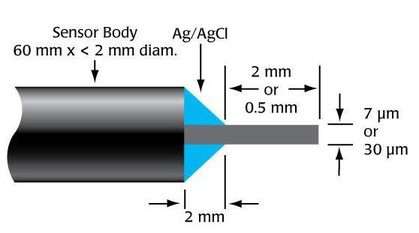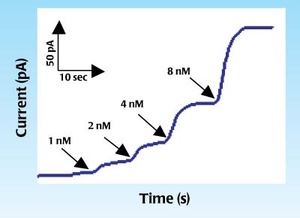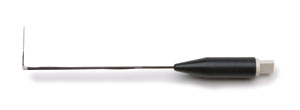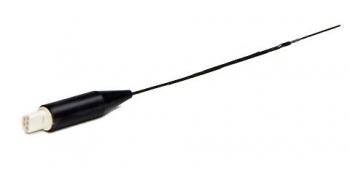ISO-NOPF Flexible Nitric Oxide (NO) Sensor
The WPI ISO-NOPF flexible nitric oxide sensor is suitable for in vivo NO measurements in the lumen of arteries and other blood vessels.
- Overview
- Specifications
- References
- Links
Bendable NO sensor that is unique! designed for in vivo applications, arteries, microvessels, and other related applications.
Key Features
- Superior NO selectivity
- Quick reaction time
- Extremely sensitive
- For use with TBR4100 and TBR1025
- Requires cable 91580 (sold separate)
- Lowest Detection Limit: 0.2 nM
- Choose diameter, length and shape
- Package
- ISO-NOPF200 package of 2
- ISO-NOPF100 package of 2
- ISO-NOPF500-CXX package of 2
- ISO-NOPF200-L10 package of 3
Options
| Order code | Tip Length | Tip Diameter | Shape | Package of |
| ISO-NOPF100 | 1-5 mm | 100 µm | Straight | 2 |
| ISO-NOPF200 | 1-5 mm | 200 µm | Straight | 2 |
| ISO-NOPF200-L10 | 10 mm | 200 µm | L-shaped | 3 |
| ISO-NOPF500-CXX | 5-10 mm | 500 µm | Straight | 2 |
| ISO-NOPF100-Lxx | 1-10 mm | 100 µm | L-Shape | 2 |
| ISO-NOPF200-Lxx | 1-10 mm | 200 µm | L-Shape | 2 |
Benefits
- Flexible sensor that is almost unbreakable
Applications
- Measurement of nitric oxide in vivo

The diameters of ISO-NOPF electrodes are 100 µm, 200 µm, and 500 µm. These totally bendable and nearly indestructible NO sensors were developed by researchers at WPI's Sensor Laboratory using the most recent developments in nanotechnology and material science. The novel sensors are built around a reference electrode and a composite graphite NO-sensing element. A special multi-layered NO-selective membrane is subsequently applied to the sensor's surface.
 Unique, Flexible NO Sensor
Unique, Flexible NO Sensor
Designed for use in applications involving arteries, microvessels, in vivo testing, and related uses. The ISO-reaction NOPF's to NO is depicted in the graph to the right.
Design
These sensors work by combining a reference electrode with a composite graphite NO-sensing element. A special multi-layered NO-selective membrane is subsequently applied to the sensor's surface.
Selectivity of WPI's NO Sensors
Other reactive species that are expected to be present in the measuring environment shouldn't affect the NO sensor's performance. Standard Nafion-coated carbon fiber NO sensors respond positively to such species. The innovative surface membrane used by WPI's NO sensor technology amplifies the reaction to NO while suppressing responses to a wide spectrum of reactive species, such as nitrite, ascorbic acid, hydrogen peroxide, catecolamines, and many more.
NOTE: A 5mm long sensor, the ISO-NOPF200 is also available at various lengths (1, 2, 3, 4 mm). Use the part number ISO-NOPF200-CXX and change the XX to the desired length when ordering custom lengths. For instance, the item number for a 1 mm flexible sensor tip is ISO-NOPF200-C01. The following custom lengths for this sensor are available to purchase: 1, 2, 3, or 4 millimeters.
The ISO-NOPF500 nitric oxide sensor functions like a conventional ISO-NOP 2mm sensor but is meant to resemble the dry, carbon fiber ISO-NOPF sensors. The sensor is available in several lengths ranging from 5 to 10 mm. It makes use of the unique combination electrode technology developed by WPI, in which a single sheilded sensor design houses both the reference electrode and the nitric oxide sensing element.
The original nitric oxide sensor, the ISO-NOP, is excellent for cell suspensions and cell cultures, among many other uses. The new ISO-NOPF500 can be used in the same way but has the following benefits instead:
- No sleeves or filling solutions are necessary.
- Like other ISO-NOPF sensors, this one is adaptable and robust.
- Rapid response time with high sensitivity—ten times more sensitive than the ISO-NOP
- Useful in acidic environments
- Extended sensor tip compared to ISO-NOP
- Greater linear range compared to ISO-NOP (range is based on the length of the sensor tip)
- Nitrite method or SNAP technique calibration
NOTE: Use the part number ISO-NOPF500-CXX and change the XX to the desired length when ordering custom lengths. For instance, the item number for a flexible 10mm sensor tip is ISO-NOPF500-C10. The following custom lengths for this sensor are available to purchase: 5, 6, 7, 8, 9, or 10 millimeters.
L-shaped Sensor

The distinctive L-shaped ISO-NOPF200-L10 nitric oxide sensor was created especially for use in tissue bath investigations and related applications. The sensor's design makes it easier to put the electrode inside the lumen of the tissue vessel under investigation. The flexible tip of the ISO-NOPF200-L10 measures 200 µm in diameter.
The instrument was used in these investigations:
- Murine strain differences in inflammatory angiogenesis of internal wound in diabetes.
(2017). Biomedicine & Pharmacotherapy, 86, 715??У724. - Moraxella catarrhalis -produced nitric oxide has dual roles in pathogenicity and clearance of infection in bacterial-host cell co-cultures.
Mocca, B., Yin, D., Gao, Y., & Wang, W.
(2015). Nitric Oxide, 51, 52??У62. - The role of rpoS, hmp, and ssrAB in Salmonella enterica Gallinarum and evaluation of a triple-deletion mutant as a live vaccine candidate in Lohmann layer chickens.
Cho, Y., Park, Y. M., Barate, A. K., Park, S.-Y., Park, H. J., Lee, M. R., ??¶ Hahn, T.-W.
(2015). Journal of Veterinary Science, 16(2), 187??У194.
You can also visit site of the manufacturer.


